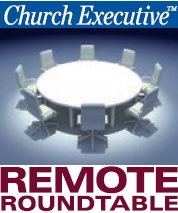
 Audio, Video, Lighting, Acoustics (AVLA) • Way Finding & Digital Signage • Security & Surveillance
Audio, Video, Lighting, Acoustics (AVLA) • Way Finding & Digital Signage • Security & Surveillance
From a professional perspective, when you think about the audio, video and / or lighting elements or technologies that are most engaging in churches right now, what springs to mind?
Doug Hood: Any leader who stands on a church stage wants the congregation to be engaged. Whether teaching a sermon or leading in worship, you want to look out and see people who are connected and involved. Sadly, this is often not the case.

President & Owner
at CSD Group
Worship Pastor
Author, The Worship Unicorn
Can technology automatically fix this problem? No way. But there are many ways technology can help you move towards engagement.
When people feel visually or audibly disconnected from the source, it’s nearly impossible for them to engage. I’ve been in many venues where a bad A/V system has been addressed with quick fixes over the years — and it’s killing the message. A/V systems that are outdated or “covered in band-aids” hinder your ability to communicate.
On the flip side, when people feel a natural and powerful connection to the pastor or worship leader, they’re more likely to be physically and spiritually drawn into the overall worship experience. There’s a big, fancy word for this type of experience: “immersive.”
The intent of an immersive AVLA system is to envelope the congregation in the experience, rather than having them only look at the experience. An immersive system encourages people to become participants rather than spectators.
How can a church ensure its audio, video and lighting elements are as engaging as possible?
Hood: Treat your loudspeaker system and room acoustics as one system.

Senior Pastor
First Baptist Forney
(Forney, Texas)
Often in acoustically disastrous rooms, people think that buying good loudspeakers will fix the acoustics. Not true. If you have a bad room now, you’ll still have a bad room after new loudspeakers.
These two systems go hand in hand, so don’t break them apart. If you take the time to design them together, your room will work well for both music and spoken word. An experienced audio designer and acoustician can provide a holistic approach and offer you a total solution.
Furthermore, there are custom systems available today that allow you to alter the acoustic signature of the room, and move audio sources throughout the room in real time. We recently unveiled such a system. Instead of a crowd of people facing just a few loudspeakers on the stage, they’re surrounded by speakers — literally “wrapped” in sound. The opportunities are endless!
When evaluating options for lighting and visuals, consider the entire room as a canvas, not just the front wall. As with audio, lighting and visuals can be used above seating areas, to the sides, and even to the rear. Again, the intent is to create an atmosphere where people are in the experience, not looking at it.
For nearly every church we’re designing now, we take advantage of the benefits of RBGW (red, blue, green, white) house lighting. This allows the entire room — not just the stage area — to be painted in color. This way, people feel more connected to the platform, instead of all the color being on the platform and only white light out over the congregation. It isn’t the perfect fit for every church, but I’ll tell you that it’s almost a standard now for most churches we talk to.

Account Executive
Headrick Signs & Graphics
We’ve seen similar trends in video. Rather than multiple smaller screens, more venues are moving to a single, giant center screen. With this concept, the wall behind the pastor or worship team can function like digital scenery. The bigger the screen, the more immersive the experience. Whether you use an LED wall or a projector, the result is a backdrop that you can easily customize to support your message or the theme of a worship set. Think of it like a big stage prop wall — but you never need to put it away or find a place to store it.
Creating an immersive system takes significant time to design, engineer and integrate. Most churches are best served to partner with a consultant or a design/build integrator to help them cast vision, create a detailed design, and a plan for implementation. When correctly designed and deployed, these systems truly can help you create more engaging experiences.
Now, let’s get a pastor’s perspective. When your church — First Baptist Forney — first began to consider audio, video and lighting elements, what was the
desired effect?

VP Sales
Uniview Technology
(uniview tec)
Dr. Jimmy D. Pritchard: We wanted to be able to host a traditional worship service, a contemporary service, and everything in between.
We wanted it to be of concert-level quality but within the budget we’d allocated. We wanted to get the best bang for our buck.
How did the end result resemble — and differ — from what you’d originally conceived of?
Pritchard: We got just what we wanted from CSD Group: an incredibly flexible space.
If our students want to get in there and have a wild light show with smoke and all those elements, they’re good to go. Or, we can calm it down, put up some risers for a choir, and do a very traditional worship. It works perfectly.
We have an LED wall that transforms everything, really, as well as side screens. The images are as clear as the ones on your big-screen TV at home. It mesmerizes people.
The sound is phenomenal; it doesn’t matter where you’re sitting — in the bleachers, on the floor, or up close to the stage.
We’ve got all kind of bells and whistles. Both the folks we bought from and the folks who installed it really, really did us well. We’re totally pleased with how everything turned out.
Being able to easily navigate a large campus is a big element of an engaging churchgoing experience. How can that experience begin the moment someone pulls onto campus?

John Rebry: Finding your way into and around a large church campus begins even before one turns into the campus; it starts with properly sized and readable street identification signage denoting the name of the church.
If the road signage is located in the right place, it can also let someone know whether that particular drive is correct. Large church campuses often have multiple access roads into the property and should advise people if they’re entering at the right place.
Once on church property, the visitor should be further instructed by well-placed way finding signs guiding them to various key locations on the church campus. The first signs they encounter will generally be intended for people in vehicles. Does your church have spaces closest to the entrance of the building marked “Visitor Parking”? If not, this sends out a subliminal message that you aren’t welcoming newcomers. If you have the space, make sure you reserve enough parking to handle all new visitors — even in the busiest times.
Once a member, guest or visitor is walking on campus, how can way finding and / or digital signage be effectively employed to get them easily to where they need to be?
Rebry: After parking, signage intended specifically for pedestrians should be used. Although they might be similar in their function, pedestrian way finding signage is generally smaller in square footage than campus directional signage and uses smaller letter heights. The reason for this is that viewing distances are closer, and pedestrians generally have more time to read and interpret the information than does someone driving a moving car.
One exception to this is adding signage directly on the outside of the building to identify what its function is. This method can be very effective on large campuses — especially if there are multiple entrances into the building complex.
Once inside the building, there are many methods one can use to help people get to their final destination. A few of these are simple, surface-mounted wall letter signs; hanging directional cubes for large foyers; and of course, digital directional signs.
There’s nothing wrong with a good old-fashioned personal greeter, too!
Large churches are often expanding and shifting uses for different ministry spaces. As they do, how can they ensure their way finding / signage doesn’t become obsolete or outdated?
Rebry: Many churches faced with rapidly changing congregations need the ability to quickly and economically change room names or directional sign copy without having to continually outsource this to a sign supplier. Fortunately, there are a number of professional-looking tooled sign products now available for this very purpose.
Some allow removal of the clear face with a suction cup (no other tools) and the copy inside to be replaced by simply changing out the printed paper. The paper sign itself can be created by church personnel using their laptop and a printer.
Digital signage is, of course, even more cost-effective — but the initial outlay in cost is fairly substantial.
Church leadership should assign the task of keeping signage current to a specific individual or committee, as this is very often overlooked. Interestingly, long-term members never look at the signage — which makes sense if you think about it. They know where everything is, so they don’t need to!
What are some of the best, most versatile way finding & signage technologies for multi-site churches?
Rebry: Multi-site churches are faced with the same challenges as any other church. So, for the most part, the same solutions described above apply.
One difference will be in how important the marketing or branding of the church is to its leadership. In other words, the question will need to be asked by church leadership if the same logos, colors, fonts, sign styles and materials should be consistent across all campuses.
In our experience, the most successful multi-site churches have recognized this and have taken steps to ensure a common experience. Much like a fast food franchise, the overall look and feel should be as close to the same as possible should the worshipper decide to visit another campus.
Navigating to the sanctuary or main office with ease should be the goal. The case for investing in digital interior signage at multi-site churches makes more economical sense now — especially if a major change is made to the branding / logo or color schemes, as the cost to do this is virtually negligible.
What security & surveillance technologies and tools are highest priority in churches right now?
Keith Shaver: It’s a good idea for a church to periodically review its current technology for facility security and staff, member and guest safety. Burglar alarm systems, video security and facility door access control (electronic locks) for perimeter, children and nursery areas should be investigated.
Do these technologies and tools differ depending on a church’s culture or desired atmosphere?
Shaver: Yes. In a culture that’s driven, in part, by younger families’ demand for safety and security, a church must embrace video security and access control of the nursery and children’s areas, at a minimum.
When a church first approaches the prospect of upgraded or new security & surveillance technology, what assumptions do they make about what they need — and what’s the reality?
Shaver: Many times, their assumptions only extend to the primary entrances. But in reality, a church must provide a level of security and safety from the time someone enters the parking lot to the point where they’re engaging in study or worship.
This is true for all age groups. Most people agree with providing a safe environment for young children, but a church should also focus on providing safety and security for families and senior adults.
Upon arrival, the intentional use of outdoor cameras covering driveways and parking lots illustrates that safety is important to a church.
The experience continues with video cameras positioned around the facility perimeter, at entrances and play areas, for instance. Young parents will expect cameras in nurseries and children’s areas.
The same applies for senior adult areas, such as drop-off spots, elevators, and outside restrooms where seniors might be susceptible to slip-and-fall accidents. Other typical locations to monitor include storage areas, A/V equipment consoles, A/V mixing rooms, youth gathering areas, kitchens, and cash-counting rooms.
Regarding shared spaces, video coverage is recommended in worship areas, sports areas, large hallways and coffee bars. This provides an overall view and documentation of activities.
Many of these locations — certainly children’s areas and nurseries — would also benefit from the use of access control for doors leading in and out.
Why is it so important for churches to get security & surveillance right?
Shaver: Church members must feel secure in their surroundings.
When it comes to guests and visitors, the church might only get one opportunity to have them experience the worship venue or the preaching / teaching, and to determine the service’s safety aspects.
When a church does get security & surveillance right, how does it look?
Shaver: Within a church, security usually starts with an alarm system — often a burglar alarm, which provides 24-hour monitored protection for office staff and provides off-hours monitoring for incident attempts. The monitoring company will contact local law enforcement if an incident occurs.
The second technology is video security, which uses video cameras connected to a video recorder to provide a live camera view for video monitoring and recording for later review.
Third is facility access control. This component allows a church to lock and unlock perimeter doors for worship and study activities on a predefined schedule. It also provides access only to those with the proper credentials to enter those spaces. Access control ensures members, visitors and children are protected during service times, as well as during off-hours.
As a pastor, when you first considered First Baptist Forney’s security & surveillance setup, did you have any assumptions or expectations about what you might need?
Pritchard: Not too many. I knew we needed really good access control for our exterior doors, as well as outdoor video cameras.
Fortunately, Keith Shaver [Uniview Technology] was on our vision leadership team; it was the group that guided us through the entire building process. All this is in his wheelhouse. So, we basically assigned him that piece and let him run with it.
How does the end result compare to what you’d envisioned?
Pritchard: We really love the access control on the outside doors. We can run that through a cellphone or an iPad, and having it in zones is really good for our security and maintenance people. That part is a dream come true.
Also, our cameras provide incredible coverage of the building. We have 2,000 seats, and we could zero in on any single seat and read the fine print on a person’s shirt label without anybody even knowing the cameras are there.
It’s beyond what I’d anticipated. People can’t hardly be anywhere in the building without some kind of surveillance on them, and that’s really a great thing for our safety and security.
Why was it so important to get security & surveillance right at your church?
Pritchard: We certainly want to protect our kids. If somebody comes in who’s not supposed to be there, we see it and can deal with it quickly. It just adds a layer of protection.
Violent incidents at churches in recent years highlight the need for security & surveillance. But, a church should also be welcoming. How can those two objectives co-exist?
Pritchard: Perfectly. At our church, you wouldn’t know that you’re on camera when you come in, unless you’re really looking for it and have a trained eye.
We also have a security team. People want a welcoming environment, but they want to know there’s some help available if something happens.
Shaver: It’s tough to gauge aesthetics versus the deterrent value of the camera’s location. But with the use of video cameras on the rise in homes and businesses, using them is now the norm, not the exception. Overt or visible cameras show that a church prioritizes safety and act as a deterrent for persons wanting to harm attendees or the facilities. They’ll simply look elsewhere. This alone should empower a church to choose safety and security over minor visible detractions.
Even so, the detraction potential is much lower these days. Camera designs are available with several case options — bullet-, turret- and dome-style — making them much smaller than the large, bulky cameras of several years ago. For example, take a look at the residential market; the video-doorbells and small outdoor cameras in use there are also available to churches.
Additionally, new technologies for 180– and 360-degree viewing mean the camera count can be reduced by a factor of 1:4, further eliminating camera detractions. As many churches build high, open spaces or opt for vaulted ceilings, it’s easy to “lose sight” of the camera in the vast room size.
— Reporting by RaeAnn Slaybaugh


